Compiled by Rev. Eugene Hagedorn, O. F. M
NEGenWeb Project
Church/Catholic
Franciscans
![]()
![]()
![]() MISCELLANEA
MISCELLANEA![]()
![]()
Compiled by Rev. Eugene Hagedorn, O. F. M
.![]()
Chapter VIII
HISTORY OF NEBRASKA
The earliest history written of the Great Central Plain is on the dust-laden and cross-written leaves of the "Book of Rocks and Soil" beneath our feet. According to them, Nebraska originally was a mighty inland sea, covering most of the Mississippi Valley and teeming with fish, turtles, and other water animals. This happened for a long and a very remote period. Rocks, sometimes 2,000 and 3,000 feet thick, are today found cut through by rushing rivers, where at one time there was no chasm, thus showing how many hundreds of years it took for the waters to cut through such a thickness of rocky fastnesses.
As these waters finally receded, Nebraska was changed into a huge swamp with a tropic climate, and a tropical vegetation and animal life. The flora of that period reveals palms and ferns that now grow only in the torrid zone, and the fauna as well brings to light the remains of tropical animals, such as monkeys, tigers, elephants, tapirs, rhinosceroses (sic), tiny horses, some of them no larger than dogs, and other animal life representative of the torrid zone.
It is now believed that, about this age, the earth tilted, and brought extreme cold to this region. The tropical animals were driven away, some of them frozen to death in their flight. A great glacier, formed from the excessive snowfall and the swampiness of the country, covered the entire plains country. Again the earth tilted, the ice began to melt, and the movement of the immense glacier left in its wake huge rocks in many queer places, far from their usual fastnesses. These are found embedded in the earth at various places. At the same time, due to the action of the glacier, rivers, creeks and lakes were formed. The rich black humus, with its powdery silty subsoil, was formed from the mud of the glacier and the decayed vegetation, giving Nebraska one of the most fertile soils in the world.
PREHISTORIC INHABITANTS OF NEBRASKA
(Reprinted with permission of Professor Addison E. Sheldon, who wrote the following for "The Tree of Progress", Omaha, Nebraska, August 15, 1923; Valentine Peter, Editor.)
"Sometime after the ice melted and the grass grew and the rivers began to run, men came to Nebraska. We do not know just when. We do not know whence. We do know that long before white men came, even before the Indian tribes that the white men found here, came to Nebraska, people lived and died here, leaving as proof, many records that are undeniable. Proofs of the presence of these early people are found in many places and are of four principal types:
"Ancient lodge circles and buried houses, generally on hill tops.
"Burial mounds and their contents, also on hill tops.
"Flint mines and work shops.
"Picture writing on rocks.
"The hilltop people were afraid of their enemies. We know this, because they placed their homes so far from wood and water in order to have an outlook. The burden of carrying water and wood up a long hill on their backs was very great.
THEY DID THIS ONLY BECAUSE OF THEIR ENEMIES
"Today we dig down through five or six feet of soil in order to reach the floor of their house and find the fireplace in the center. In the ashes of the fireplace and on the floor we find their tools of flint and bone, with charred corn and other fragments of meals eaten long ago. If we dig carefully beneath the house floor we usually find the cellar. Their cellars were shaped like a large bottle, having a neck coming up to the floor big enough for a man's body. We find no bottles, however, in these old cellars. They used them to store food and skins and tools, and the remains of these are frequently found at the bottom of the cellar, which is usually six or eight feet below the floor.
"In the burial mounds of these ancient people we sometimes find ashes as though they, had burned their dead, or perhaps burned the soil so as to protect its contents from wild animals, In other mounds skeletons are found and along
side them, stone axes, spear heads, arrow points and many other things which the living might have used, but which they gladly buried with the dead so his spirit might have them to use in the spirit world.
115
![]()
THE FLINT MINES
"The flint mines of these people were places where they tore down rock walls (usually limestone) in order to break up the rock and get the flint which is scattered in ledges and nodules through the rock. After they secured the flint, they spent long days and months slowly chipping it into shape of tools and weapons they could use. These people also made pictures on the rocks, showing wild animals, the sun and stars and men. These pictures were their only form of writing and told the story of the tribe for those who were able to read them.
"All we know of these early people is what we learn from the remains, yet these show how the people made their living and many of the beliefs that they held. How long ago these people came to Nebraska is a problem unsolved. Some of the explorers believe that they have found skulls of a low type that indicated men who were only a little above animals and that the places where they were found indicate that these people lived here before the ice sheet covered the land, many, many thousands of years ago. It may be added that the tradition of the Indian tribes found in Nebraska by the first white men here agree in indicating their arrival in Nebraska, not more than 400 to 500 years ago, and that these early remains were left by the people who were here prior to that time.
NEBRASKA INDIAN TRIBES
"The Indian tribes found in Nebraska by the first white explorers include these: "The Otoe, Omaha, and Ponca tribes, each numbering 2,000 or 3,000 people and dwelling on both sides of the Missouri River, the Otoe in the southeast, the Omaha in the middle, and the Ponca near the mouth of the Niobrara River. These tribes were related in blood, language and
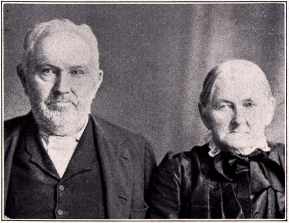
Mr. and Mrs. John (Helen) McGuane.
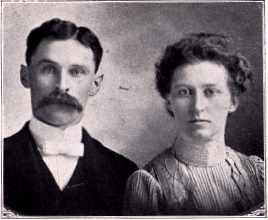
Mr. and Mrs. Richard (Margaret Cronin) McGuane.
116
![]()
customs to each other and also to the great Sioux tribes which lived farther north and west.
"The Pawnee nation occupied the central part of Nebraska from the Loup River south to the Republican and numbered about 10,000 people. Their language, customs and traditions were very different from those of any other Nebraska tribe. Their songs and stories and religion were the most wonderful of any of our Indians. They had advanced further towards civilization, and their traditions told of coming to Nebraska from the southwest.
"West of the Pawnee nation, the Indian tribes included the Brule and Ogallala, Sioux, Kiowa, Cheyenne, Arapahoe, and sometimes the Commanche. These tribes spoke different languages. They were hunting and were generally at war with the Pawnees and other tribes in eastern Nebraska. Altogether, about 40,000 Indians made Nebraska their home or hunting grounds. War among the tribes was continual, the chief cause being the possession of the best hunting grounds and flint deposits. The Pawnee, Otoe, Omaha and Ponca raised gardens of corn, beans, melons and tobacco on the moist lands along the rivers. This was the only farming done in Nebraska and although the land was rich and the rainfall not any different from that of today, these 40,000 people had a hard time to make a living in a country where 1,300,000 people now live in comfort."--A. B. Sheldon.
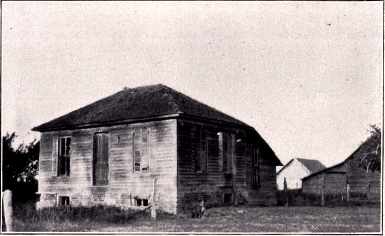
Dr. H. Mills, M. D., Frame House. First in Country--Polk County.
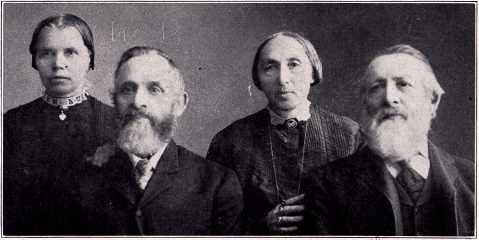
Eummelen-Ramaekers. St. Bernard
117
![]()
THRESHING IS A SHORT JOB NOW
(From the Humphrey Democrat, September 13, 1901.)
There is a wonderful difference in threshing operations of today and twenty years ago, says an exchange. Then the average farmer looked upon the job as taking three or four weeks at least. Twelve or fourteen horses would be hitched to the old horse power and plod wearily around the ring hour after hour through the hot and dusty day, and the old separator would shell out the grain through a little spout into a couple of half-bushel measures which one man would keep tally of by system of wooden pegs or by making straight marks on the side of the separator with a piece of chalk. Five or six men had to be on the dusty straw stack to care for the straw as it came over the elevator.
All fall the work would continue, the monotony occasionally being relieved by a man getting his overalls torn off by the tumbling rod or by a horse coming to grief by too much exercise. When at last the task was completed, the
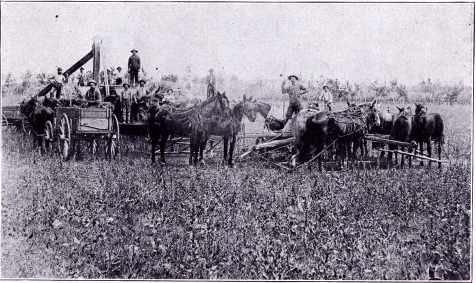
The Old Time Wemhoff-Wieser Threshing Outfit.
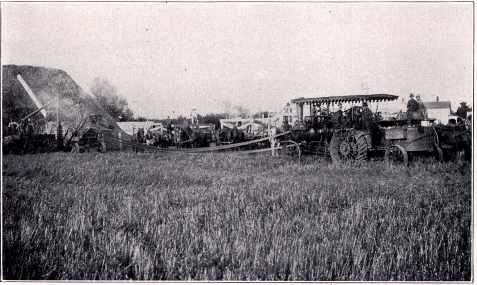
The Modern Threshing Outfit of Wm. E. Schure.
118
![]()
farm boys wouldn't have any time to rest, but would have to jump into the corn fields, where they would prance around until Christmas.
Nowadays one of those big modern steam outfits comes into a farmer's yard at twenty miles an hour, whistles, stops, backs up a few feet, lets off a hundred pounds of steam, and then the chief mogul yells for wheat or oats. The big belt begins to turn, men drive up and throw wagon loads of bundles into the big "Quintus" self-feeder and band cutter, there is a puff of smoke, a hum of wheels, a steady stream of straw onto the stack through the blow stacker, a column of grain flies through the weigher, and before the farmer's wife (who is exceedingly wrathy because the elegant dinner she had prepared is to go untouched) has time to ring the bell, the army is off up the road and ready to tackle the big job at Jones(?), where the women folks were not expecting them for a half day at least, and are thrown into a panic by the prospect of feeding thirty hungry men on fifteen minutes notice. At the end of a couple of weeks the threshing is done and the boys have a month's rest, take long breaths and enjoy life. And thus it goes. Every year the big machine works faster and faster, and every year the jobs grow shorter.--Selected.
The compiler, for general reasons, doubts about the threshing crew foresaking (sic) a good dinner to hurry up the work at the neighbor's.
A SKETCH OF THE PRAIRIE OF THE GREAT AMERICAN DESERT (NEBRASKA),
BY MR. NICOLET
(Cfr. History of the Western Missions and Missionaries in the United States, Series of Letters by P. J. de Smet, S. J., N. Y. P. J. Kennedy Publ. Co., p. 27).
"Consider the boundless extent of a prairie--scan one by one its undulations, and borne as it were from wave to wave, from valley to hilltop, find yourself in presence of the limitless plain which is spread out before you; journey onward-hours, days, and weeks will succeed each other, and emotions of ever-varying delight will captivate the mind, while the spectacle of inexhaustible wealth and new beauties will fascinate the eye. Without doubt here will be moments in which the ardors of a burning sun, and the privation of pure water capable of allaying the thirst, will force you to remember that the best of earthly joys have their hidden thorn; but these trials are rare and brief. A gentle breeze almost continually refreshes the atmosphere in these vast plains, and the surface is so uniform as to baffle a surprise from the most crafty enemy. The route is one field of verdure, enamelled (sic) with odoriferous wild flowers, whose brilliant beauty has no witness but the azure firmament. It is particularly during summer that the aspect of the prairie breathes gayety, grace and life, and if there be any one moment in which they may excite all the sympathies of the traveller (sic), it is when an Indian hunter in pursuit of the deer or bison, animates this immense solitude with his presence and motions. I pity the man whose heart remains unaffected before so ravishing a spectacle." (Nicolet 1. c.).
A GREAT STORM (BLIZZARD),
SUNDAY,
APRIL 13, 1873
On Sunday, April 13, 1873, there commenced one of the most terrible storms ever experienced in Nebraska. The early spring had been warm and vegetation had started rapidly. On the above date there came up a severe thunder storm accompanied by a heavy wind. After a while the temperature began to fall rapidly, the rain changed to snow; and then began in earnest one of the most terrible of snow storms ever known in the western prairies, lasting three days. The storm was so blinding, that it was certain death for any one to venture a few rods from the house. So heavy was the snowfall and so violent the wind that drifts were formed from twenty to thirty feet in height, and packed so completely that they did not melt away for several weeks. In this storm great damage was done to the trees of the county. Both fruit and forest trees were so badly injured that great numbers of them died. A great many cattle perished. One man lost seventy-four, another lost one hundred, and many lost all or nearly all their stock. Dead birds were found everywhere, and the bodies of a great many deer, and other wild animals were found scattered over the prairie. Cfr. History of Nebraska-Andreas Company, Chicago, 1882. p. 933 (Hall County).
GERMAN SOCIETIES AT COLUMBUS,
NEBRASKA. THE GERMAN MAENNERCHOR
The Germans are a social people and fond of instrumental and vocal music. The German and Swiss Americans of Columbus were no exception, and, as early as 1877 they had organized a 'singing society' or Maennerchor (Male Choir), which, in the first quarter century of its existence made a record to be proud of. Many of the leading business men in the city were once on its roster, and many a splendid entertainment it gave to the public.
For years the Society's annual Christmas celebration, its Sylvester Ball, the masquerade ball with its original costumes, the annual picnic and the Stiftungsfest (Anniversary of Organization), were the climax of Columbus social life, bringing a variety of stirring activities that
119
![]()
|
Residence of F. H. Morrow, M. D., Columbus. |
||
Mr. James E. North, Columbus. |
Rev. James Mary Ryan, Columbus. |
Mr. John Kyle, Columbus. |
|
Rev. James Mary Ryan's Residences. |
||
120
![]()
were exceedingly welcome in the humdrum of existence and the monotony of daily routine.
Among its charter members might be mentioned Emil Pohl, its first director and the soul of the society for many years--Frank Gores, Henry Gass, Carl Segelke, Adolph Jaeggi, Louis Schreiber, Leopold Jaeggi, Robert Uhlig, Gustave Schroeder, Paul Hagel, John Wermut, Gustav Fahbaum, John Seipp, David Schupbach, John Stauffer, Ferdinand Brodfuehrer and others.
Mr. Pohl had been a member of a Prussian Military Band and had received a thorough musical education in Germany. He knew how to enthuse his singers and induce them to do their best. Hence the Columbus Maennerchor was a welcome guest at the Festivals of the Singers (Saengerfeste) and returned home with the usual high honors. In 1894 the Columbus Maennerchor acted as host to the Singers of Omaha, Lincoln, Madison and other Nebraska towns, and the day was such as to still arouse pleasant memories in the minds of the old members.
John Stauffer was the first President of the Maennerchor, from 1877 to 1887, and was succeeded in turn by David Schupbach, Carl Segelke, Louis Schreiber, Carl Rohde, August Boettcher, Louis Meyer, W. J. Walter, Gottlieb Frischholz, W. L. Boettcher, Fred Staub. One person in the organization was always particularly welcome--the Comedian. He usually had an original song as a surprise, as well as pleasantries for the children at the glorious Yuletide celebration.
But the Maennerchor did not seem to be able to rivet the loyalty of the younger generation despite sporadic rivivals (sic) and flareups. Once, especially, it seemed that the old organization was headed for a new lease on life, when it was proposed to build a new home. With unlooked for ardor, the people gathered enough money to build a splendid home for the Society--the new Maennerchor Hall. The building was dedicated in December, 1912. The festival was an imposing one, singers from Omaha, Lincoln, Grand Island and Madison under the direction of "Altmeister" Theodore Rudolf Reese, of Omaha, carrying out a fine program.
Blow after blow hit the organization, however. Prohibition, heretofore no worry of the Society, depressed its festivities, the old leaders were dying away, and the once gay place experienced the gloom of silence, where once German "Gemuetlichkeit and Lebensfreude" had held sway.
Still the organization managed to struggle along. Such grand old personages of Columbus as the Reverend R. William Neumaerker, long pastor of the German Reformed Church, and Reverend Herman Miessler, equally long the pastor the Immanuel Lutheran Church, held the members together. The organization was thus able to celebrate its Golden Jubilee in 1927.
But the end was not far off. As the expenditures continued to surpass the income, and the meetings frequently lacked a quorum, the Society finally voted, in April, 1928, to dissolve, after voting $53.00 towards the fund for writing the history of the Germans in Nebraska.
The building was sold to the newly-formed Trinity Evangelical Lutheran congregation in 1928, and the Maennerchor Hall was turned into a church. And thus the time-honored and splendid old institution-The Columbus Maennerchor-passed into history.
Mr. Carl Rodhe, one of the few living members of the old Society, deserves special acknowledgment for information concerning The Columbus Maennerchor Society. (Adapted from Rev. Steger's article in Omaha Daily Tribune).
THE SCHWEIZER VEREIN
(THE
SWISS SOCIETY)
The Schweizer Verein was organized as The Gruetli Verein, September 22, 1894. The name was later changed to The Schweizer Verein of Columbus. Its purpose is the cultivation of the German language and the Swiss dialect, and also the preservation of the popular manners and customs of Switzerland. The society also has a mutual benefit association section. The Schweizer Verein became affiliated with the Nordamerikanische Schweizerbund in 1895.
THE SCHWEIZER FRAUEN
VEREIN
(THE SWISS LADIES' SOCIETY)
The Schweizer Frauen Verein was organized March 16, 1905, with fifteen charter members, the present membership being 90. Its purpose is much the same as the above society. The first officers were: Mrs. R. Nyfeller, President; Mrs. Carl Roelle, Vice-President; Mrs. P. F. Luchsinger, Secretary, and Mrs. A. Abts, Treasurer. It is also affiliated with the Nordamerikanische Schweizerbund.
THE FIRST CEMETERY
NEAR COLUMBUS,
COL. TEL., AUGUST 8, 1909
The Hon. George W. Brown, father of Ellis Brown, station master of the Union Pacific R. R. at Columbus, related a story, which will be news to the average citizen of Columbus, and especially to those of younger years. The general understanding is that the city cemetery was chosen by the first comers as a burial ground. Mr. Geo. W. Brown states that when he purchased his old farm (now the Carl Rhode place), two or three miles north and east of the city, he found thereon a cemetery, with nearly
121
![]()
thirty graves. Most of the graves contained the bodies of emigrants, who died on the old California trail, but some of them contained the bodies of the earliest settlers in Columbus. The early cemetery was located on a high hill in conformity with the custom of those days, when a cemetery was seldom or never found in a valley. It is probable that most of the bodies were removed from the old burying ground when the city cemetery was laid out.
We are informed by an old settler that as late as 1879-1880 there were a number of graves in the yards of people living south of the St. Mary's hospital, in the fields and near many homes.
John Reck, a born politician and diplomat,, died 1863, and was laid to rest in the old cemetery on the hill, which later was part of the Fred Blaser farm. (History of Platte County, Past and Present, Vol. I, p. 228).
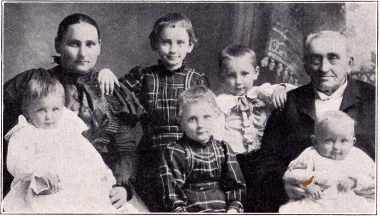
The Pat Murray Family.
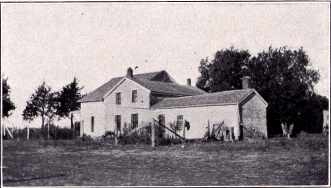
The Pat Murray Home Near Columbus.
122
![]()
|
|||